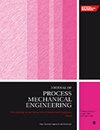Thermal efficiency evaluation in shell-and-tube heat exchangers: A CFD-based parametric study
IF 2.2
4区 工程技术
Q2 ENGINEERING, MECHANICAL
Proceedings of the Institution of Mechanical Engineers, Part E: Journal of Process Mechanical Engineering
Pub Date : 2024-07-23
DOI:10.1177/09544089241262481
引用次数: 0
Abstract
In this study, a novel approach was employed to enhance the performance of a Bowman brand EC-2028 shell-and-tube heat exchanger (STHE) by introducing perforated plates. The heat exchanger was first tested in a real system within a laboratory environment to establish baseline performance data. Computational fluid dynamics (CFD) analysis revealed that flow velocities in the middle tubes were higher due to their alignment with the main flow direction, resulting in decreased heat transfer efficiency. To address this issue, a perforated plate with concentric circles was introduced at the cold fluid entry. This plate, devoid of central holes, featured circles with radii of 9, 18, 27, 36, 45, 54, and 63 mm, each containing 6, 10, 17, 24, 30, 36, and 42 equidistant holes, respectively. The introduction of the perforated plate led to a decrease of approximately 0.33°C in the hot outlet temperatures, indicating an improvement in heat transfer efficiency. To further enhance performance, various configurations were tested by progressively closing holes from the innermost to the outermost circles. Eight different configurations, including the control, were evaluated under counterflow conditions. The CFD model was validated with experimental data before introducing the perforated plates, ensuring the accuracy of the simulations. The findings demonstrated significant improvements in heat transfer efficiency, with the optimized perforated plate configurations leading to more uniform flow distribution and reduced pressure drops. This study's novel approach of using perforated plates to modulate flow and enhance thermal performance highlights a new avenue for optimizing STHE designs, contributing to more efficient thermal management solutions in industrial processes.管壳式热交换器的热效率评估:基于 CFD 的参数研究
本研究采用了一种新方法,通过引入穿孔板来提高 Bowman 牌 EC-2028 管壳式热交换器 (STHE) 的性能。该热交换器首先在实验室环境中的真实系统中进行了测试,以建立基准性能数据。计算流体动力学(CFD)分析表明,由于中间管道与主流向一致,因此流速较高,导致传热效率降低。为了解决这个问题,在冷流体入口处引入了一个同心圆穿孔板。这种板没有中心孔,半径分别为 9、18、27、36、45、54 和 63 毫米,每个半径分别包含 6、10、17、24、30、36 和 42 个等距孔。引入穿孔板后,热出口温度降低了约 0.33°C,表明热传导效率有所提高。为了进一步提高性能,还测试了从最内圈到最外圈逐渐闭孔的各种配置。在逆流条件下,对包括对照组在内的八种不同配置进行了评估。在引入穿孔板之前,利用实验数据对 CFD 模型进行了验证,以确保模拟的准确性。研究结果表明,优化的穿孔板配置可使流体分布更均匀,压降更小,从而显著提高了传热效率。这项研究采用穿孔板调节流量和提高热性能的新方法,为优化 STHE 设计开辟了一条新途径,有助于在工业流程中提供更高效的热管理解决方案。
本文章由计算机程序翻译,如有差异,请以英文原文为准。
求助全文
约1分钟内获得全文
求助全文
来源期刊
CiteScore
3.80
自引率
16.70%
发文量
370
审稿时长
6 months
期刊介绍:
The Journal of Process Mechanical Engineering publishes high-quality, peer-reviewed papers covering a broad area of mechanical engineering activities associated with the design and operation of process equipment.

 求助内容:
求助内容: 应助结果提醒方式:
应助结果提醒方式:


